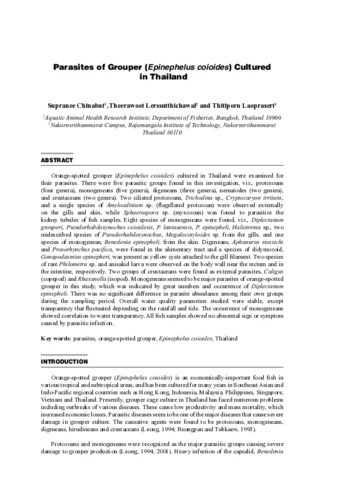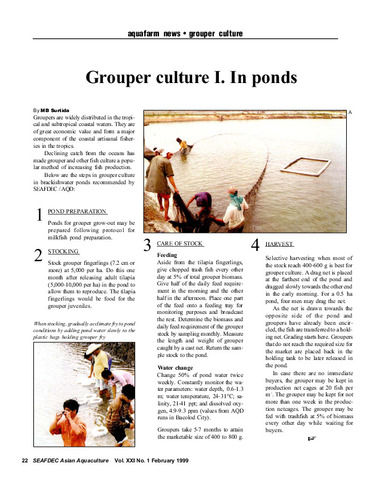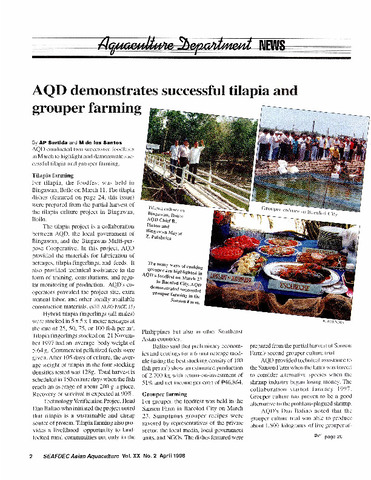Perlihatkan publikasi sederhana
Parasites of grouper (Epinephelus coioides) cultured in Thailand
| dc.contributor.author | Chinabut, Supranee | |
| dc.contributor.author | Lerssutthichawal, Theerawoot | |
| dc.contributor.author | Laoprasert, Thitiporn | |
| dc.contributor.editor | Nagasawa, Kazuya | |
| dc.date.accessioned | 2020-07-22T03:06:38Z | |
| dc.date.available | 2020-07-22T03:06:38Z | |
| dc.date.issued | 2005-03 | |
| dc.identifier.citation | Chinabut, S., Lerssutthichawal, T., & Laoprasert, T. (2005). Parasites of grouper (Epinephelus coioides) cultured in Thailand. In K. Nagasawa (Ed.), Recent Advances in Diagnosis and Prevention of Fish and Shrimp Diseases in Southeast Asia (pp. 267–279). Tigbauan, Iloilo, Philippines: Aquaculture Department, Southeast Asian Fisheries Development Center. | en |
| dc.identifier.isbn | 9718511732 | |
| dc.identifier.uri | http://hdl.handle.net/10862/5932 | |
| dc.description.abstract | Orange-spotted grouper (Epinephelus coioides) cultured in Thailand were examined for their parasites. There were five parasitic groups found in this investigation, viz., protozoans (four genera), monogeneans (five genera), digeneans (three genera), nematodes (two genera), and crustaceans (two genera). Two ciliated protozoans, Trichodina sp., Cryptocaryon irritans, and a single species of Amyloodinium sp. (flagellated protozoan) were observed externally on the gills and skin, while Sphaerospora sp. (myxozoan) was found to parasitize the kidney tubules of fish samples. Eight species of monogeneans were found, viz., Diplectanum grouperi, Pseudorhabdosynochus coioidesis, P. lantauensis, P. epinepheli, Haliotrema sp., two undescribed species of Pseudorhabdosynochus, Megalocotyloides sp. from the gills, and one species of monogenean, Benedenia epinepheli, from the skin. Digeneans, Aphanurus stossichi and Prosorhynchus pacifica, were found in the alimentary tract and a species of didymozoid, Gonapodasmius epinepheri, was present as yellow cysts attached to the gill filament. Two species of rare Philometra sp. and anisakid larva were observed on the body wall near the rectum and in the intestine, respectively. Two groups of crustaceans were found as external parasites, Caligus (copepod) and Rhaxanella (isopod). Monogeneans seemed to be major parasites of orange-spotted grouper in this study, which was indicated by great numbers and occurrence of Diplectanum epinepheli. There was no significant difference in parasite abundance among their own groups during the sampling period. Overall water quality parameters studied were stable, except transparency that fluctuated depending on the rainfall and tide. The occurrence of monogeneans showed correlation to water transparency. All fish samples showed no abnormal sign or symptom caused by parasitic infection. | en |
| dc.language.iso | en | en |
| dc.publisher | Aquaculture Department, Southeast Asian Fisheries Development Center | en |
| dc.subject | groupers | en |
| dc.subject | Epinephelus coioides | en |
| dc.subject | Thailand | en |
| dc.subject | Protozoa | en |
| dc.subject | Monogenea | en |
| dc.subject | Digenea | en |
| dc.subject | Crustacea | en |
| dc.title | Parasites of grouper (Epinephelus coioides) cultured in Thailand | en |
| dc.type | Book chapter | en |
| dc.citation.spage | 267 | en |
| dc.citation.epage | 279 | en |
| dc.citation.bookTitle | Recent Advances in Diagnosis and Prevention of Fish and Shrimp Diseases in Southeast Asia | en |
| dc.subject.asfa | parasites | en |
| dc.subject.asfa | grouper culture | en |
| dc.subject.asfa | intensive aquaculture | en |
| dc.subject.asfa | cage culture | en |
| dc.subject.asfa | blood | en |
| dc.subject.asfa | mucus | en |
| dc.subject.asfa | cysts | en |
| dc.subject.asfa | histology | en |
| dc.subject.asfa | water quality | en |
| dc.subject.asfa | water samples | en |
| dc.subject.asfa | water transparency | en |
Files in this item
Publikasi ini ada di koleksi berikut
-
Recent Advances in Diagnosis and Prevention of Fish and Shrimp Diseases in Southeast Asia [43]
Terminal Report of the Regional Fish Disease Project on “Development of Fish Disease Inspection Methodologies for Artificially-Bred Seeds” Funded by the Government of Japan Trust Fund from 2000 to 2004


 AQD Access only
AQD Access only


